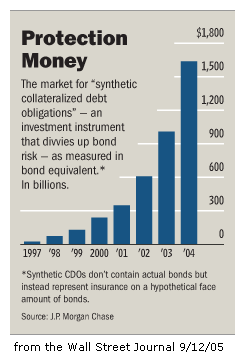

|
| weblog/wEssays | home | |
|
Derivatives: Wall Street Fiddles While Rome Smolders (March 23, 2006)  A fire is already smoldering in the gasoline warehouse, but Wall Street is fiddling
away, fanning the embers. Rome won't burn, it will explode. What's the gasoline?
Derivatives--trillions of dollars' worth. What's the smoldering fire? Wall Street's
insatiable appetite for ever riskier "investment vehicles" and "hedges."
A fire is already smoldering in the gasoline warehouse, but Wall Street is fiddling
away, fanning the embers. Rome won't burn, it will explode. What's the gasoline?
Derivatives--trillions of dollars' worth. What's the smoldering fire? Wall Street's
insatiable appetite for ever riskier "investment vehicles" and "hedges."
But don't take my word for it. Check out the March 22 edition of the business-centric Wall Street Journal for this story: Debt Party: Investors Scoff at Risk, But Their Borrowing May Haunt Them This isn't exactly a new story--note that the second chart dates from last Fall--but that doesn't mean the risks aren't real. If anything, they're increasing in a heretofore unimaginable manner. Like a rubber band being stretched tauter and tauter, the risks can only increase so much; at some point, the band (and market) will snap. Longtime readers know that I have suggested reading mathematician Benoit Mandelbrot's exploration of market risk, The Misbehavior of Markets  In a nutshell: Mandelbrot proves that standard "portfolio management" models and tools
radically underestimate the risks inherent in any chaotic system, i.e. the market. He
graphically illustrates with historical charts that the stock market does not perform as statistical
models would suggest; rather, it is prone to sudden highly volatile drops and upward
spikes, much as the fractal geometries he developed would predict. He then shows you a real stock
chart and one based on fractals; you won't be able to tell them apart.
In a nutshell: Mandelbrot proves that standard "portfolio management" models and tools
radically underestimate the risks inherent in any chaotic system, i.e. the market. He
graphically illustrates with historical charts that the stock market does not perform as statistical
models would suggest; rather, it is prone to sudden highly volatile drops and upward
spikes, much as the fractal geometries he developed would predict. He then shows you a real stock
chart and one based on fractals; you won't be able to tell them apart.
In other words, the full amount of risk in the market cannot be accurately predicted. We can, however, look at these charts and see that risks are completely underestimated, and that the amount of money being leveraged in derivatives is truly frightening. But let's hear what the Wall Street Journal has to say about risk and complacency: Debt investors expect prices in the market to be stable and returns to be meager for as far as the eye can see. So they are coming to a natural conclusion: It is time to borrow more money and make riskier bets. That type of thinking is often dangerous.Long-Term Capital Management, you'll recall, was the outfit which believed they'd discovered the secret to managing risk--the Black-Scholes formula for pegging the value (price) of options (a form of risk management which even regular investors can buy--the familiar puts and calls). Lo and behold, the market stubbornly refused to follow their predicted models, and LTCM's over-exposure to derivative losses collapsed the firm and very nearly the global banking system. Only the sudden mobilization of the storied "Plunge Protection Team" saved the day. Interestingly, the market has floated along without any prolonged or severe spikes of risk since that blow-up in 1998--almost eight years of ever lower measurements of volatility. (Take a look at the VIX, a measure of option volatility, if you need more proof.) Gazing at these charts, one wonders if the market isn't due for one of the sudden, seemingly random appearances of risk predicted by fractal geometries. Perhaps it's a good time to recall the old dictim: Cash is King. copyright © 2006 Charles Hugh Smith. All rights reserved in all media. I would be honored if you linked this wEssay to your site, or printed a copy for your own use. |
||
| weblog/wEssays | home |